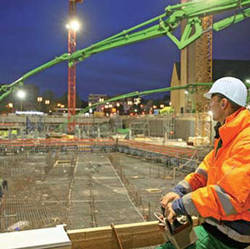
Putzmeister products are causing a sensation time and time again when used during crisis situations, irrespective of their original intended purpose. However, day in, day out, thousands of the German manufacturer‘s machines and installations constantly prove their reliability under much less spectacular circumstances of use all around the world.
Putzmeister, which was founded in 1958 by Grad. Eng. Karl Schlecht, is a company which has grown by itself, has business all around the world and is an innovative specialist machine manufacturer. At the beginning of 2012, the SANY group, the market leader for concrete pumps in China, became its new owner and is continuing to build upon the German company‘s innovative prowess. Putzmeister develops and produces technically superior and service-oriented machines in the following areas: concrete pumping, truck-mounted concrete pumps, stationary concrete pumps, booms and accessories, industrial technology, pipe delivery of industrial solids, concrete placement and removal of excavated material in tunnels and underground, robot and materials handling technology, mortar machines, plastering machines, screed conveying, injection and external cleaning of aircraft. The installations are used in the construction industry, for mining and tunneling in large scale industrial projects, in the precast industry, power plants and sewage treatment plants as well as in waste incineration plants.
Truck-mounted concrete pumps have a very wide range of concrete-related uses, for example, the construction of bridges or high-rise buildings. They consist of a truck, a supporting device, a piston pump and a boom with 4 to 6 arm hinges. The hydraulic pump is powered by the truck‘s diesel engine. Thus, no external power supply is required to operate it. The machine is operated remotely, allowing the operator to move the flexible boom arm as well as control the concrete flow rate. The concrete required is fed through a truck mixer to the feed pump‘s intake chamber.
The M70-5 used in Fukushima is mounted on a semitrailer, which is driven by a 500 hp tractor unit. In order to distribute the pump‘s 80-tonne weight evenly, the vehicle has 10 axles with a total length of 2.14 m. Putzmeister‘s M70-5 is the world‘s largest truck-mounted concrete pump. As if that wasn‘t enough, with the M42-5, Putzmeister is bringing another innovative product to the market that is setting the standard once again. The new design, from boom to chassis, has allowed the all-important overall road traffic weight to be reduced to below 32 tonnes. This means that there‘s still room for things like disposable load, equipment, water and fuel. In addition, the clever relocation of the feed pipe in the boom area and the improved rigidity of the steel construction keep the distribution boom steady. Thus, even when the boom is fully extended, concrete can be poured with precision. The running costs of the M42-5 have been considerably reduced as specially designed parts were used and less fuel is required. The volume of hydraulic oil required alone has been halved to just 300 litres!
From September 2012, the M42-5 will be used at construction sites, including for building stadia, in the hot climes of Qatar. In preparation, extensive field tests are already under way, proving its suitability for extreme conditions. Field-test machines are fitted with an array of various online sensors that monitor the hydraulic system as well as having many other functions. Regular inspections provide information, above all, on the mechanical condition of the machines. This, together with feedback from the machine operators, is fed into the ongoing optimisation phase in order to ensure that a comprehensively tried-and-tested, and reliable product is on offer as soon as production begins.
Putzmeister stands for maximum quality, which unites the company and its customers. The condition of the hydraulic oil is particularly important for problem-free operation. Putzmeister has been taking advantage of OELCHECK lubricant analyses since 1994. Hydraulic oil is tested for:
In the OELCHECK laboratory the main characteristics of the hydraulic oil, such as viscosity, additivation and wear protection, are carefully tested in each case. The cleanliness of the hydraulic oil also plays an extremely important role. It is essential for a trouble and wear-free operation of the installations. In general, approximately 80% of hydraulic system failures are caused by impurities in the hydraulic oil. Therefore, by counting the particles, OELCHECK carefully examines hydraulic oil cleanliness (also see „Determining cleanliness categories“, ÖlChecker Winter 2004, pg. 10 et seq.).
Putzmeister sees the hydraulic oil used in a pump as an important structural component, which is a decisive factor for performance and functional safety. Therefore, it‘s not just oil manufacturers‘ product specifications that are compared. Only hydraulic oils that have been proven to meet the company‘s high quality requirements are approved for use in Putzmeister machines. As a general rule, HLP hydraulic oils, whose performance often far exceeds the minimum requirements of DIN 51524-T2, are used Putzmeister will decide which viscosity category to apply for each case (HLP 22, 32, 46 or 68) on the basis of the respective climatic conditions and other operational conditions. The oil levels in the machines vary from < 100 litres to > 1,000 litres. In the new M42-5, the newly developed hydraulic system meant that the oil volume could be reduced to approx. 300 litres. Putzmeister was able to take this even further. Thanks to the considerably lower oil levels, operating costs fall and, after an oil change, less waste oil is released into the environment. However, since the volume of hydraulic oil is considerably lower, the demands made on it are that much greater. However, if only Putzmeister-approved oils are used and regular OELCHECK lubricant analyses are carried out, these oils will rise to any challenge.
